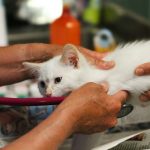Hyperthyroidism in cats is a common yet often overlooked condition. Recognizing the key symptoms early can significantly improve your feline friend’s health and well-being. From increased appetite to noticeable weight loss, understanding these signs is vital. Effective treatment solutions are available that can restore balance to your cat’s life. This guide will equip you with the insights needed to help your cat thrive despite this challenge.
Overview of Hyperthyroidism in Cats
Hyperthyroidism in cats is a common endocrine disorder characterised by an overproduction of thyroid hormones. These hormones are crucial in regulating metabolism, and their excess can lead to various health issues in felines. The condition primarily stems from benign growths, known as adenomas, on the thyroid glands. While the exact cause of these growths remains unclear, they significantly impact a cat’s health and behaviour.
Cela peut vous intéresser : Transforming Your Cat”s Nocturnal Habits: Effective Strategies for Coordinating Their Schedule with Yours
The prevalence of hyperthyroidism in cats has increased over the past few decades, particularly affecting middle-aged and older cats. Studies suggest that nearly 10% of cats over ten years old may develop this condition. This rise has been attributed to several factors, including dietary influences, environmental chemicals, and genetic predispositions.
Early detection of hyperthyroidism is crucial for effective management and treatment. Symptoms such as weight loss, increased appetite, hyperactivity, and excessive thirst can be indicators of the disorder. Regular veterinary check-ups and blood tests can help in identifying the condition early, allowing for timely intervention.
A voir aussi : Transforming Shelter Life: Proven Strategies for Using Environmental Enrichment to Alleviate Stress in Cats
Understanding hyperthyroidism in cats and its implications can significantly enhance a cat’s quality of life. By recognising the signs and seeking veterinary advice promptly, cat owners can ensure their pets receive the necessary care and treatment.
Key Symptoms of Hyperthyroidism in Cats
Identifying the symptoms of hyperthyroidism in cats is essential for timely diagnosis and treatment. This common condition manifests through noticeable changes in a cat’s behaviour and physical health.
Increased Appetite and Weight Loss
One of the hallmark signs is a paradoxical combination of increased appetite and weight loss. Despite consuming more food, affected cats lose weight due to accelerated metabolism. This is because their bodies burn calories faster than they can consume them.
Hyperactivity and Restlessness
Cats with hyperthyroidism often exhibit hyperactivity and restlessness. They may seem more energetic or anxious than usual, engaging in excessive movement or play. This behavioural shift is linked to the overproduction of thyroid hormones, which stimulate the nervous system.
Changes in Grooming Habits and Behaviour
Changes in grooming habits are also indicative. Cats may groom excessively or, conversely, neglect grooming altogether, leading to an unkempt appearance. Additionally, behavioural changes such as increased vocalisation, aggression, or irritability can occur. These shifts are due to the hormonal imbalance affecting the cat’s overall well-being.
Recognising these symptoms early can significantly impact a cat’s treatment outcomes. Regular observation and veterinary consultations are crucial for managing hyperthyroidism effectively, ensuring the cat’s health and comfort.
Diagnostic Procedures for Hyperthyroidism
Diagnosing hyperthyroidism in cats requires a comprehensive approach to ensure accurate identification and effective treatment. The diagnosis of hyperthyroidism involves several key steps, each crucial for confirming the condition.
Initial Veterinary Assessment
The process begins with an initial veterinary assessment. During this stage, the vet conducts a thorough physical examination, evaluating the cat’s overall health and identifying any symptoms indicative of hyperthyroidism. This assessment helps determine the necessity for further diagnostic tests.
Blood Tests and Hormone Level Evaluation
Blood tests are a pivotal part of the diagnosis of hyperthyroidism. These tests measure the levels of thyroid hormones, particularly thyroxine (T4), in the cat’s bloodstream. Elevated T4 levels typically confirm the presence of hyperthyroidism. This hormone level evaluation is essential for differentiating hyperthyroidism from other conditions with similar symptoms.
Imaging Techniques
In some cases, imaging techniques like ultrasound or scintigraphy are utilised to assess the thyroid glands’ size and structure. These techniques provide detailed insights into the presence of adenomas or other abnormalities. Accurate imaging is vital for planning appropriate treatment strategies.
The importance of an accurate diagnosis cannot be overstated, as it lays the groundwork for effective management and improved outcomes for cats suffering from hyperthyroidism.
Treatment Options for Hyperthyroidism
When it comes to managing hyperthyroidism in cats, there are several treatment options available, each with its own advantages and considerations.
Medication Options
One of the most common treatment for hyperthyroidism is the administration of medication, particularly methimazole. This drug works by inhibiting the production of thyroid hormones, thereby helping to control the symptoms. Methimazole can be given orally or as a topical gel, making it versatile for different cat preferences. Regular blood tests are essential to monitor hormone levels and adjust dosages accordingly.
Radioactive Iodine Therapy
Another effective treatment for hyperthyroidism is radioactive iodine therapy. This involves a single injection of radioactive iodine, which selectively targets and destroys overactive thyroid tissue. It is considered a permanent solution and often results in normal thyroid function without the need for ongoing medication. However, it requires a brief hospital stay and may not be suitable for all cats, especially those with other health issues.
Surgical Options
For some cats, surgical removal of the thyroid glands, known as thyroidectomy, is a viable option. This treatment for hyperthyroidism effectively eliminates the source of excessive hormone production. While it carries surgical risks, it can be a permanent solution, particularly when performed by an experienced veterinary surgeon.
Dietary Management in Hyperthyroidism
Managing a diet for hyperthyroid cats is crucial in alleviating symptoms and supporting overall health. Prescription diets specifically formulated for hyperthyroid cats can be highly effective. These diets are typically low in iodine, which is essential for thyroid hormone production. By reducing iodine intake, these diets help manage hormone levels, thus controlling symptoms.
Nutrition plays a significant role in managing hyperthyroidism symptoms. A balanced diet ensures that cats receive the necessary nutrients without exacerbating their condition. High-quality protein sources are vital, as they help maintain muscle mass often lost due to increased metabolism. Additionally, antioxidants and omega-3 fatty acids can support immune function and reduce inflammation.
For those considering a homemade diet, it’s important to consult a veterinarian or a pet nutritionist. Homemade diets must be carefully balanced to ensure they meet the cat’s nutritional needs without providing excess iodine. It’s crucial to avoid ingredients like fish and certain grains that are high in iodine.
Overall, a well-planned diet for hyperthyroid cats can significantly enhance their quality of life, complementing other treatment options and supporting long-term health.
Monitoring and Follow-Up Care
Regular veterinary check-ups are essential for effectively managing hyperthyroidism in cats. These visits allow for the continuous monitoring of thyroid levels, ensuring that treatments are working as intended and adjustments are made when necessary. Consistent check-ups help in identifying any potential complications early, allowing for prompt intervention.
Monitoring thyroid levels is crucial in maintaining a cat’s health. Blood tests are typically used to measure hormone levels, particularly thyroxine (T4), to ensure they remain within a safe range. Adjustments to medication or treatment plans might be required based on these results, ensuring optimal management of the condition.
Observing changes in a cat’s behaviour and health is equally important. Owners should be vigilant for any signs of weight loss, changes in appetite, or behavioural shifts, as these might indicate a need for treatment adjustments. Cats with hyperthyroidism may exhibit new symptoms or changes in existing ones, which should be promptly reported to a veterinarian.
Key points to consider for effective monitoring include:
- Scheduling regular veterinary visits.
- Keeping a detailed record of the cat’s behaviour and health changes.
- Ensuring open communication with the veterinarian to discuss any concerns or observations.
Common Questions about Hyperthyroidism
Understanding hyperthyroidism in cats involves addressing several frequently asked questions. These insights can help cat owners make informed decisions regarding their pet’s health.
Can Hyperthyroidism Be Cured?
Hyperthyroidism can be managed effectively, but a permanent cure is primarily achieved through radioactive iodine therapy or surgical removal of the thyroid glands. These treatments target the overactive thyroid tissue, potentially restoring normal hormone levels. However, not all cats are candidates for these procedures due to other health considerations.
What Are the Long-Term Effects?
The long-term effects of hyperthyroidism, if left untreated, include severe weight loss, heart disease, and high blood pressure. These complications can significantly impact a cat’s overall health. Effective management through medication, dietary changes, and regular monitoring can mitigate these risks, ensuring a better prognosis.
How Does It Affect a Cat’s Quality of Life?
Hyperthyroidism can drastically alter a cat’s quality of life. Symptoms like weight loss, increased appetite, and hyperactivity can be distressing for both the cat and the owner. With appropriate treatment, many cats experience a significant improvement in their well-being, regaining energy and maintaining a healthier weight. Regular veterinary care is crucial in managing the condition and enhancing the cat’s life quality.
Tips for Prevention and Management
Preventing hyperthyroidism in cats involves a proactive approach, focusing on regular vet visits and lifestyle adjustments. Routine health screenings are crucial. They allow for early detection of any hormonal imbalances, ensuring timely intervention. Regular vet visits help monitor a cat’s overall health, facilitating the identification of potential issues before they escalate.
Environmental factors play a significant role in managing hyperthyroidism. Reducing exposure to environmental chemicals, such as flame retardants and certain cleaning products, can mitigate risk factors. Opting for natural, pet-safe products and maintaining a clean living environment are effective strategies. Additionally, providing a balanced diet low in iodine can support thyroid health.
Identifying early warning signs is essential for prevention. Owners should be vigilant for symptoms like increased appetite, weight loss, or behavioural changes. These indicators can signify the onset of hyperthyroidism, prompting the need for veterinary consultation. Understanding these signs enables owners to act swiftly, ensuring better outcomes for their pets.
By incorporating these practices, cat owners can significantly reduce the risk of hyperthyroidism, promoting a healthier, more comfortable life for their feline companions.
Resources for Further Information
When navigating hyperthyroidism in cats, accessing reputable veterinary resources is invaluable. Understanding the condition and its treatment options can significantly impact your cat’s quality of life.
Recommended Veterinary Organisations and Websites
Numerous veterinary organisations offer comprehensive information on feline hyperthyroidism. The American Veterinary Medical Association (AVMA) and the International Cat Care are excellent starting points. These organisations provide detailed articles and guidelines to help pet owners understand the complexities of hyperthyroidism.
Importance of Consulting with a Veterinarian
While online resources are helpful, the importance of consulting with a veterinarian cannot be overstated. Veterinarians possess the expertise to offer tailored advice and treatment plans, ensuring your cat receives the best care. Regular check-ups and open communication with your vet are crucial for effective management.
Links to Articles and Research Studies
For those interested in delving deeper, many veterinary websites feature links to peer-reviewed articles and research studies. These resources can offer insights into the latest advancements in hyperthyroidism treatment and management. Engaging with such materials can empower you to make informed decisions regarding your pet’s health.
By leveraging these resources, you can enhance your understanding and support your cat’s well-being.
Conclusion and Final Thoughts
Understanding hyperthyroidism in cats is essential for providing the best care possible. Recognising the key symptoms, such as increased appetite, weight loss, and behavioural changes, is crucial for early detection and effective management. Treatments like medication, radioactive iodine therapy, and dietary adjustments offer various options tailored to each cat’s needs.
Proactive pet care is vital in managing hyperthyroidism. Regular veterinary check-ups ensure that any changes in your cat’s condition are promptly addressed. This proactive approach not only helps in managing the disease but also enhances your cat’s overall quality of life.
Fostering a supportive community among cat owners can be incredibly beneficial. Sharing experiences and insights with others facing similar challenges can provide comfort and practical advice. Engaging in forums or local pet groups can help you stay informed and feel supported.
By understanding hyperthyroidism and being proactive in your cat’s care, you can help ensure a healthier, happier life for your feline friend. Encourage open dialogue with your veterinarian and fellow pet owners to continue learning and adapting to the needs of your cat.
















